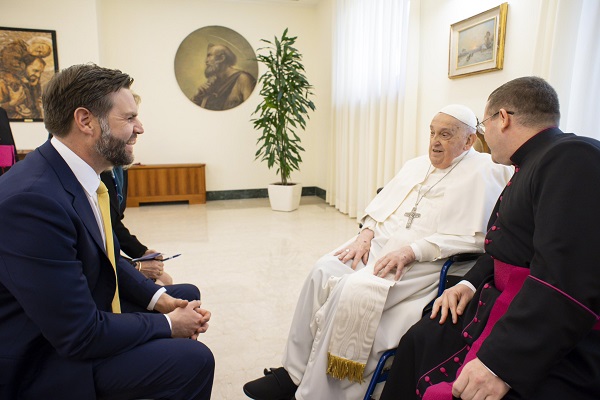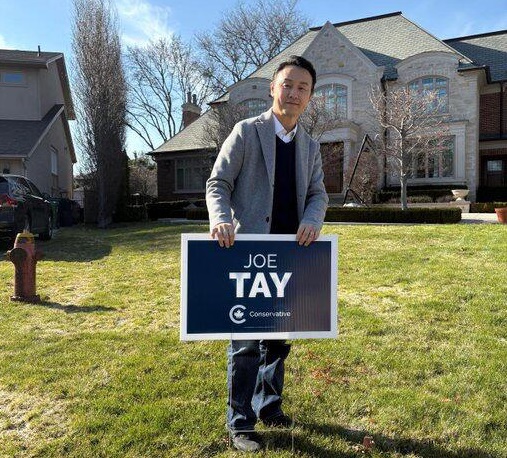Alberta
Province defends post-secondary funding changes. Says United Kingdom, Denmark, Finland, Hong Kong using performance-based funding

Minister Nicolaides meets with student leaders prior to announcing a new post-secondary funding announcement.
From The Province of Alberta
Transforming post-secondary funding
A new outcomes-based post-secondary funding approach will increase transparency and accountability and help build a modern and diverse workforce for the future.
Under the new funding model, a portion of government funding to colleges, universities and polytechnics will be based on achieving key performance measures. Performance measures will encourage institutions to improve services, increase efficiencies and create opportunities for Albertans through strong labour market outcomes and innovative programs and research.
“This is a new and completely transformative funding model for our universities, colleges and polytechnics. Our new approach will help ensure students are set up for success by encouraging institutions to produce job-ready graduates. Students make a significant investment in their post-secondary education, and it is essential we do everything possible to give them a rewarding career at the end of their studies. By shifting the focus to performance, we will ensure taxpayer dollars are being used in the most responsible way possible.”
“The University of Calgary has the ability to create the ‘arc to the future’ for Calgary and help re-imagine Alberta. The outcomes-based funding model is not only a tremendous opportunity to transform our post-secondary system, but to graduate a workforce that is capable of adaptation, with the skills and abilities to innovate and to support economic growth and diversification.”
“We look forward to working with government to implement the new outcomes-based approach to funding. This approach should improve predictability in government funding levels and enhance accountability for results delivery, both of which will benefit our students.”
“Alberta’s post-secondary presidents welcome the opportunity to work with the Government of Alberta, our learners and other stakeholders in building a performance-based model that will enable us to achieve an overall vision for Alberta’s post-secondary system, that builds on the strengths and core mission of each institution, and that maximizes the quality of our learning and research environments so that learners and communities can reach their highest potential.”
“Alberta’s students deserve an institutional funding model that is both modern and evidence-based. ASEC supports the changes made by the Government of Alberta towards a model that fits our values of transparency, accountability, affordability and predictability. We look forward to working with the government in the further development of the Campus Alberta Grant allocation.”
In addition to tying public investment to results, government is also transforming its relationship with post-secondary institutions by negotiating three-year funding agreements. Investment management agreements will include specific performance targets for each institution. They will also specify the government funding each institution will receive if they meet their performance targets. Three-year terms will help institutions plan for the future and build on their record of excellence.
The amount of funding tied to performance outcomes will begin at 15 per cent of operational funding for 2020-21 and gradually increase to a maximum of 40 per cent by 2022-23. A small number of performance measures will be introduced for the 2020-21 academic year, and more measures will be gradually introduced over the next three years to a total of about 15.
Quick facts
- Government provides operational funding to 26 universities, colleges and polytechnics every year, but historically, this funding has not been tied to any targets or outcomes. While government provides many different kinds of grants to post-secondary institutions, only operational funding through the Campus Alberta Grant will be tied to performance.
- The MacKinnon Report identified that the current post-secondary funding structure does not link funding to the achievement of specific goals or priorities for the province, such as ensuring the required skills for the current and future labour market.
- Outcomes-based funding is a global trend in higher education. About 35 U.S. states use a form of performance-based funding. Over the past 10 years, additional jurisdictions have implemented various methods of performance-based funding, such as the United Kingdom, Belgium, Spain, Portugal, Italy, Norway, Sweden, Denmark, Finland, Poland, Australia, New Zealand and Hong Kong.
- While performance measures will be finalized after discussions with post-secondary institutions, students and faculty, some examples may include:
- graduate employment rate
- median graduate income
- graduate skills and competencies
- work-integrated learning opportunities
- administrative expense ratio
- sponsored research revenue
- enrolment (including potential targets for domestic students, international students and under-represented learners)
- Performance measures will also be weighted differently depending on the institution. For example, different performance measures will be more important to different kinds of institutions.
- Institutions that meet all of their targets will receive 100 per cent of their allocated funding.
- If an institution does not meet its targets, the institution will receive funding that is proportionate to its level of achievement. For example, if an institution achieves 90 per cent of its target, it will receive 90 per cent of its funding for that target.
Alberta
CPP another example of Albertans’ outsized contribution to Canada

From the Fraser Institute
By Tegan Hill
Amid the economic uncertainty fuelled by Trump’s trade war, its perhaps more important than ever to understand Alberta’s crucial role in the federation and its outsized contribution to programs such as the Canada Pension Plan (CPP).
From 1981 to 2022, Albertan’s net contribution to the CPP—meaning the amount Albertans paid into the program over and above what retirees in Alberta received in CPP payments—was $53.6 billion. In 2022 (the latest year of available data), Albertans’ net contribution to the CPP was $3.0 billion.
During that same period (1981 to 2022), British Columbia was the only other province where residents paid more into the CPP than retirees received in benefits—and Alberta’s contribution was six times greater than B.C.’s contribution. Put differently, residents in seven out of the nine provinces that participate in the CPP (Quebec has its own plan) receive more back in benefits than they contribute to the program.
Albertans pay an outsized contribution to federal and national programs, including the CPP because of the province’s relatively high rates of employment, higher average incomes and younger population (i.e. more workers pay into the CPP and less retirees take from it).
Put simply, Albertan workers have been helping fund the retirement of Canadians from coast to coast for decades, and without Alberta, the CPP would look much different.
How different?
If Alberta withdrew from the CPP and established its own standalone provincial pension plan, Alberta workers would receive the same retirement benefits but at a lower cost (i.e. lower CPP contribution rate deducted from our paycheques) than other Canadians, while the contribution rate—essentially the CPP tax rate—to fund the program would likely need to increase for the rest of the country to maintain the same benefits.
And given current demographic projections, immigration patterns and Alberta’s long history of leading the provinces in economic growth, Albertan workers will likely continue to pay more into the CPP than Albertan retirees get back from it.
Therefore, considering Alberta’s crucial role in national programs, the next federal government—whoever that may be—should undo and prevent policies that negatively impact the province and Albertans ability to contribute to Canada. Think of Bill C-69 (which imposes complex, uncertain and onerous review requirements on major energy projects), Bill C-48 (which bans large oil tankers off B.C.’s northern coast and limits access to Asian markets), an arbitrary cap on oil and gas emissions, numerous other “net-zero” targets, and so on.
Canada faces serious economic challenges, including a trade war with the United States. In times like this, it’s important to remember Alberta’s crucial role in the federation and the outsized contributions of Alberta workers to the wellbeing of Canadians across the country.
Alberta
Made in Alberta! Province makes it easier to support local products with Buy Local program

Show your Alberta side. Buy Local. |
When the going gets tough, Albertans stick together. That’s why Alberta’s government is launching a new campaign to benefit hard-working Albertans.
Global uncertainty is threatening the livelihoods of hard-working Alberta farmers, ranchers, processors and their families. The ‘Buy Local’ campaign, recently launched by Alberta’s government, encourages consumers to eat, drink and buy local to show our unified support for the province’s agriculture and food industry.
The government’s ‘Buy Local’ campaign encourages consumers to buy products from Alberta’s hard-working farmers, ranchers and food processors that produce safe, nutritious food for Albertans, Canadians and the world.
“It’s time to let these hard-working Albertans know we have their back. Now, more than ever, we need to shop local and buy made-in-Alberta products. The next time you are grocery shopping or go out for dinner or a drink with your friends or family, support local to demonstrate your Alberta pride. We are pleased tariffs don’t impact the ag industry right now and will keep advocating for our ag industry.”
Alberta’s government supports consumer choice. We are providing tools to help folks easily identify Alberta- and Canadian-made foods and products. Choosing local products keeps Albertans’ hard-earned dollars in our province. Whether it is farm-fresh vegetables, potatoes, honey, craft beer, frozen food or our world-renowned beef, Alberta has an abundance of fresh foods produced right on our doorstep.
Quick facts
- This summer, Albertans can support local at more than 150 farmers’ markets across the province and meet the folks who make, bake and grow our food.
- In March 2023, the Alberta government launched the ‘Made in Alberta’ voluntary food and beverage labelling program to support local agriculture and food sectors.
- Through direct connections with processors, the program has created the momentum to continue expanding consumer awareness about the ‘Made in Alberta’ label to help shoppers quickly identify foods and beverages produced in our province.
- Made in Alberta product catalogue website
Related information
-

 International2 days ago
International2 days agoJD Vance was one of the last people to meet Pope Francis
-

 2025 Federal Election2 days ago
2025 Federal Election2 days agoOttawa Confirms China interfering with 2025 federal election: Beijing Seeks to Block Joe Tay’s Election
-

 2025 Federal Election1 day ago
2025 Federal Election1 day agoBREAKING: THE FEDERAL BRIEF THAT SHOULD SINK CARNEY
-

 COVID-191 day ago
COVID-191 day agoNearly Half of “COVID-19 Deaths” Were Not Due to COVID-19 – Scientific Reports Journal
-

 2025 Federal Election1 day ago
2025 Federal Election1 day agoHow Canada’s Mainstream Media Lost the Public Trust
-

 2025 Federal Election1 day ago
2025 Federal Election1 day agoCHINESE ELECTION THREAT WARNING: Conservative Candidate Joe Tay Paused Public Campaign
-

 Media23 hours ago
Media23 hours agoCBC retracts false claims about residential schools after accusing Rebel News of ‘misinformation’
-

 2025 Federal Election2 days ago
2025 Federal Election2 days agoReal Homes vs. Modular Shoeboxes: The Housing Battle Between Poilievre and Carney






